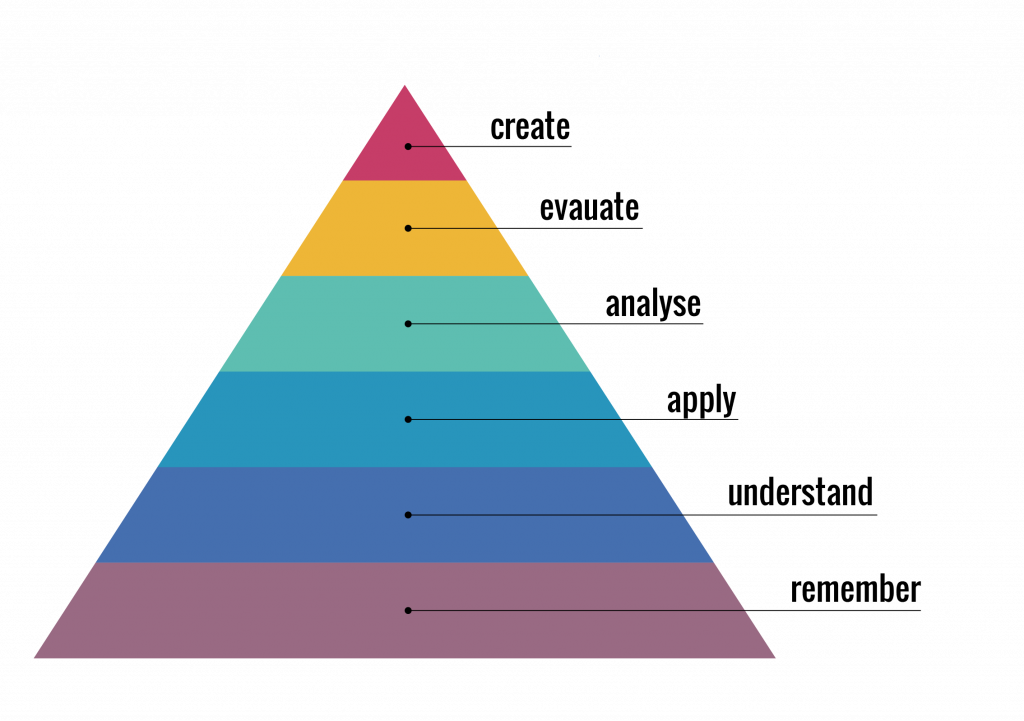
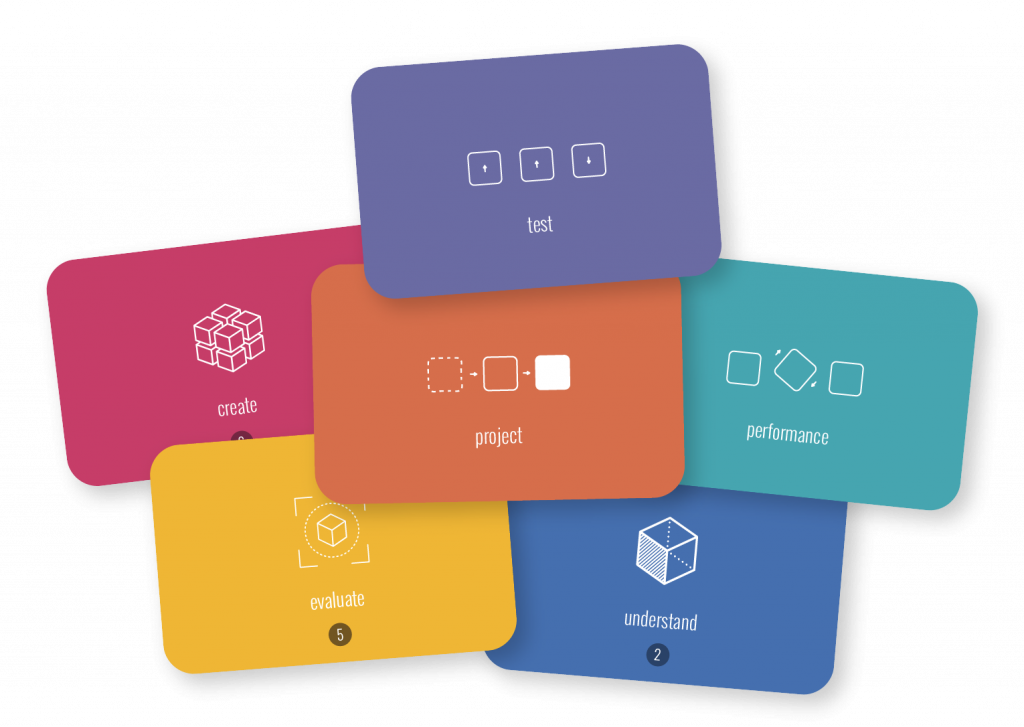
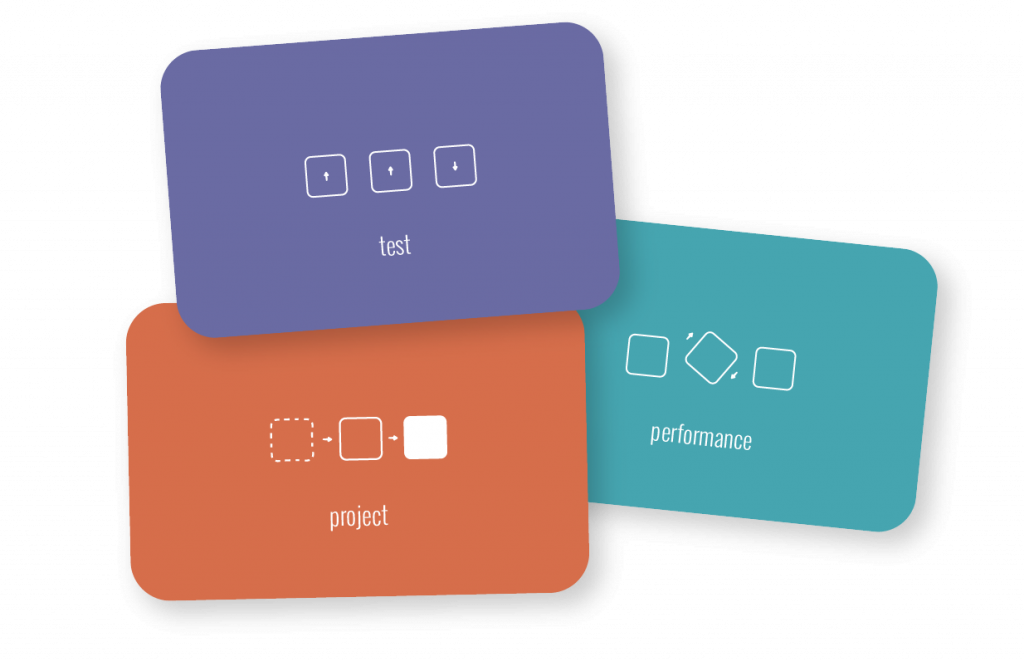
About the
Learning
Assessment
Design
Deck
Design effective learning assessment.
The Theory Behind
The Learning Objective Design Card Deck is a practical tool to make the process of defining learning objectives and assessment strategies for any type of educational experience easier, creative, collaborative and even fun. The cards and the method to use them is based on long and well established research in Pedagogy and Education Sciences. This is a brief overview of the theory behind the card deck, why and when it is useful to use it as well as some tips on how to get the most out of it.
Background
The Taxonomy of Educational Objectives, published in 1956 by Benjamin Bloom and collaborators, widely known as Bloom’s Taxonomy, is a framework to categorize and describe educational goals. The Taxonomy has been used by generations of teachers and instructors in their practice to better define the learning obectives of their educational interventions.
More recently, in 2001, the original Bloom’s Taxonomy was reviewed by a group of psychologists, instructional and curriculum researchers that published A Taxonomy for Teaching, Learning, and Assessment, also familiarly know as the Revised Bloom’s Taxonomy.
The revised taxonomy substituted the nouns of the original taxonomy with more dynamic verbs and gerunds to emphasize the dynamic nature of learning. These verbs address the cognitive dimensions, the different types of thinking processes learners encounter and practice while acquiring new knowledge and skills.
This approach is especially suited to active learning and problem-based approaches and other contemporary ways to structure learning experiences. Moreover the revised version, with its action-verbs and process oriented approach, allows educators to frame and define learning objectives with a learner-centred approach right from the initial steps of the learning design process.
When and Why it is used
Defining learning objectives before any educational experience is an established best practice. Bloom’s taxonomy is a powerful framework that can be used to construct, articulate and write the learning outcomes of a program, a course or a learning unit.
According to Vanderbilt University’ Center for Teaching, learning goals support both teachers and learners alike to understand the pedagogical interchange within the learning environment. Organizing such goals as structured sets of learning objectives provides clarification for both teachers and learners. They also help teachers to “plan and deliver appropriate instruction”, “design valid assessment tasks and strategies” and “ensure that instruction and assessment are aligned with the objectives”.
Constructive Alignment
When designing learning objectives, a key component is usually also the articulation of assessment strategies to assess learners’ proficiency in regard to the learning objective. Regardless, wether this assessment is implemented as summative or formative assessment, a key challenge in this process to address the appropriate cognitive dimension in the chosen assessment as certain assessment techniques are more suitable than others for specific learning objectives according to the cognitive level of Bloom’s taxonomy.
To make this concept as approachable as possible, the Learning Assessment Design Deck is utilizing a simplified classification presented by Guilbert in 1998 that can be summarized as the ability to recall facts, the ability to interpret data and ability to solve a new problem. This classification translates to Bloom’s taxonomy on the levels of remember & understand, apply & analyze and evaluate & create.
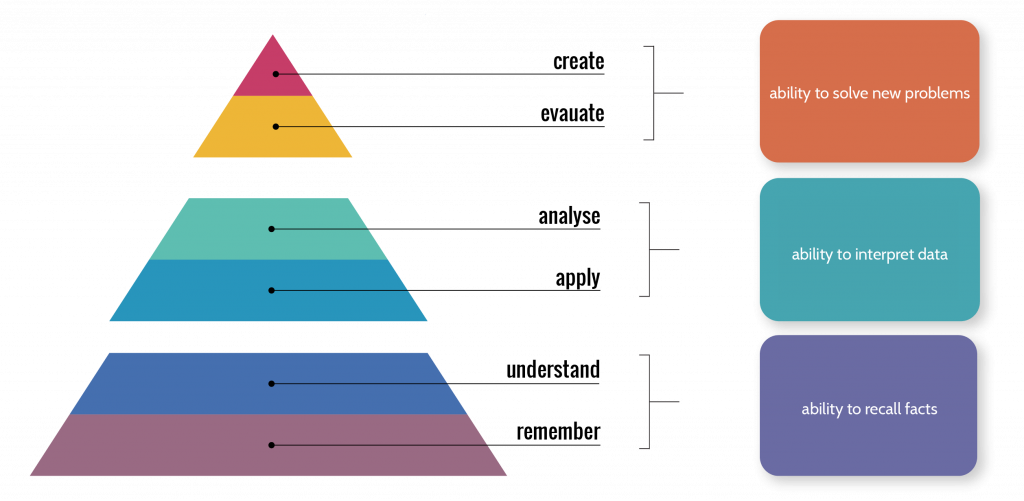
In addition, the classification allows for assessment mechanisms to be divided into direct and indirect methods. As means of direct observation, skills an be directly observed in the performance in a practical test. Indirect methods encompass written and oral tests and carrying out projects.
The Learning Assessment Design Deck is using the classification of test, performance and project to model appropriate assessment mechanisms hat address the different levels of Bloom’s taxonomy. For this, the competence model presented by Miller in 1990 serves as a way to align the assessment mechanisms on levels of cognition, as in knows or knows how, as well as behavior, as in shows how or does.
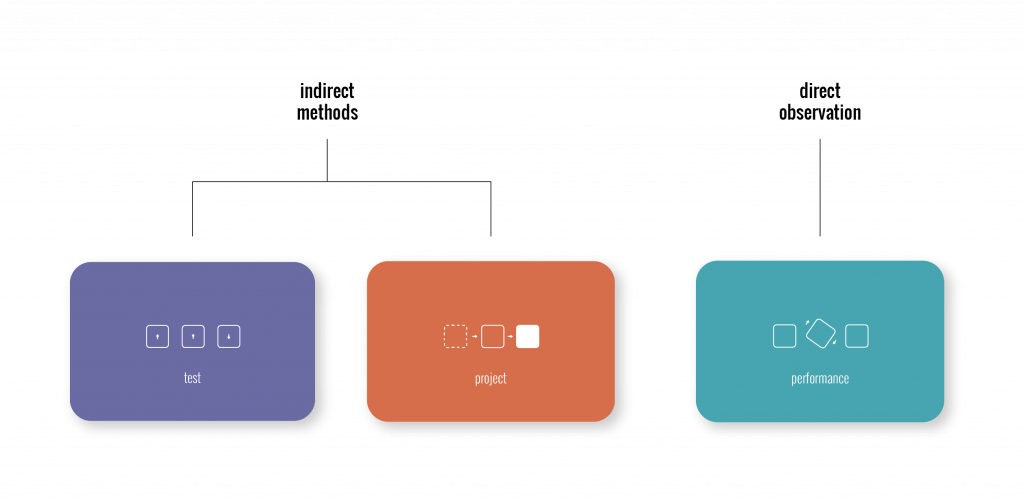
As a result, the Learning Assessment Design Deck ensures that chosen assessment mechanism are constructively aligned to the addressed cognitive dimensions of the learning objective while at the same time providing a comprehensive classification of assessment types that makes it easy to educators to identify suitable assessment strategies on various levels of competency. In this process the Learning Assessment Design Deck helps to constructively align teaching as proposed by Biggs in 1996.
The Learning Assessment Design Deck
The Learning Assessment Design Deck takes the elements of Bloom’s framework and turns them into a set of modules – the cards – that can be manipulated and composed in a natural and easy way. The modular and interactive nature of the deck makes the process of ideating, constructing and writing learning objectives and constructively aligned assessment mechanisms less abstract and more tangible.
The cards of the Learning Assessment Design Deck translate the taxonomy and its conceptual model into a practical tool and allow the framework to be used in a more dynamic and playful way.
The deck also adds a narrative-like compositional strategy to compose meaningful learning objective and assessment strategy sentences and statements. Thanks to the operator cards – which provide bits of truncated sentences that need to be completed – the learning objectives and aligned assessment mechanisms can be designed in a learner-centered and actionable way.
Used in brainstorming-like sessions, the deck facilitates the design process and potentially unleashes out-of-the-box thinking, fostering discussion, creativity and collaboration when used in group settings. The Learning Assessment Design Deck helps to produce fast tangible results that are ready to be used in the design of educational experiences, course outlines, curriculum and syllabus design, etc.
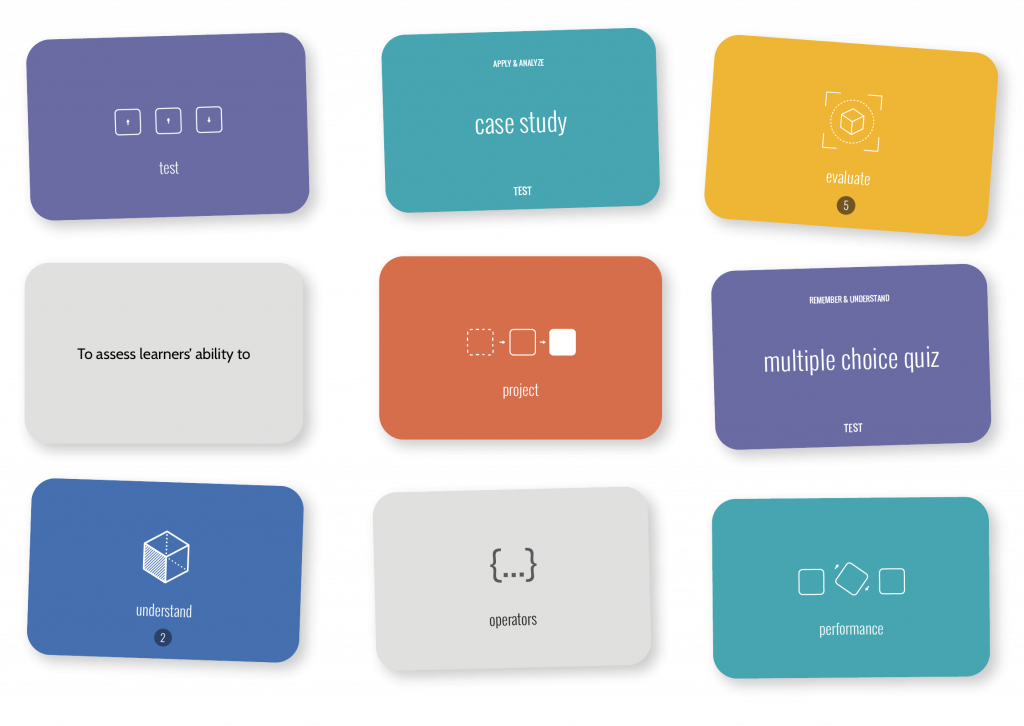
Get the cards
Get the Cards
THE CARDS
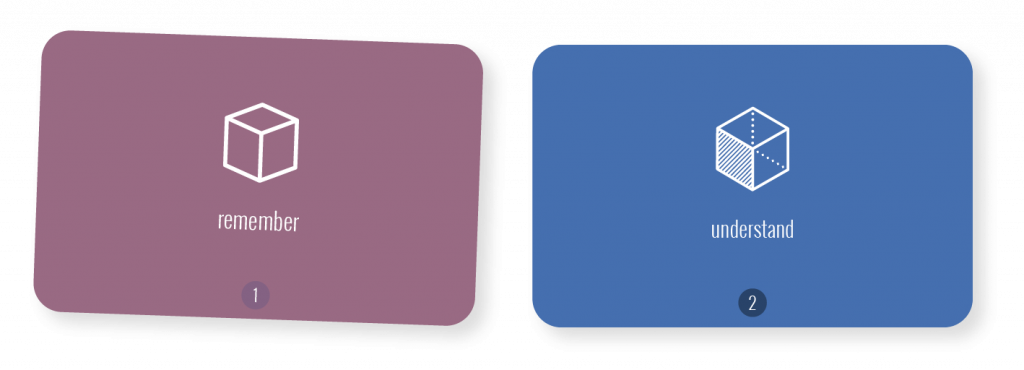
Cognitive Dimensions
The cognitive dimensions from Blooms’ taxonomy are represented in the deck with verb cards for its six layers of remember, understand, apply, analyze, evaluate and create.
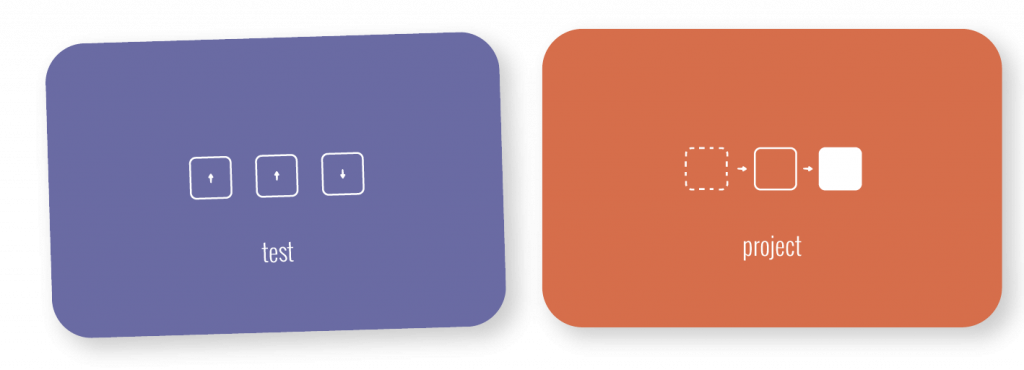
AssEssment STrategies
Assessment strategies are constructively aligned to the cognitive dimensions. There are three distinct types of assessment cards: Test, Performance and Project.

AssEssment Mechanisms
The assessment cards provide different assessment mechanisms for each cognitive dimension that help to align the learning processes and assessment strategies.
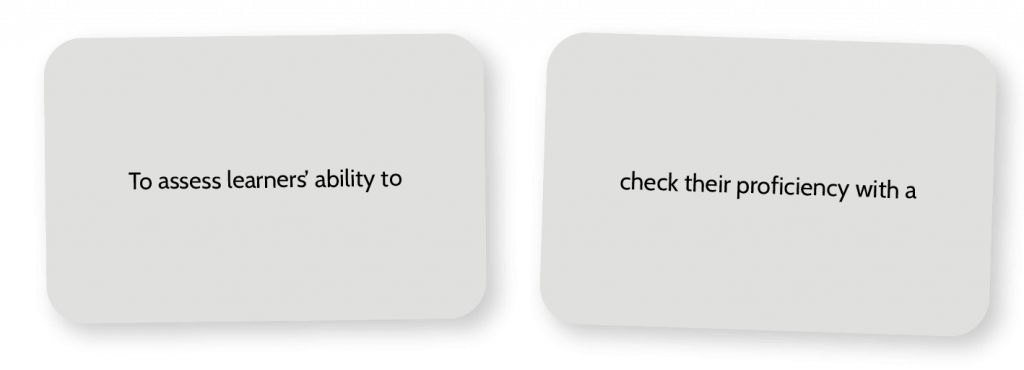
Operators
Together with the operator cards, the verb and assessment cards are used to write learning objectives and assessment strategies for any educational context.
Use the Learning Assessment Design Deck to constructively align learning outcomes and assessment strategies for any educational context.
Learning Objective Composition
The operator cards are used with the verb cards to construct statements that constitute learning objectives in form of descriptive sentences. The cards guide the interactive process of articulating learning outcomes for any educational context.
Results are ready for immediate usage, e.g. in tutorial descriptions, project requirements or curriculum outlines etc. The Learning Assessment Design Deck supports the creation of consistent and coherent learning objectives through separation of structural integrity and learning content. This allows quick ideation with direct tangible output.
In addition, the card deck support the design of constructively aligned assessment strategies, ensuring conceptual consistency when assessing learners’ proficiency.

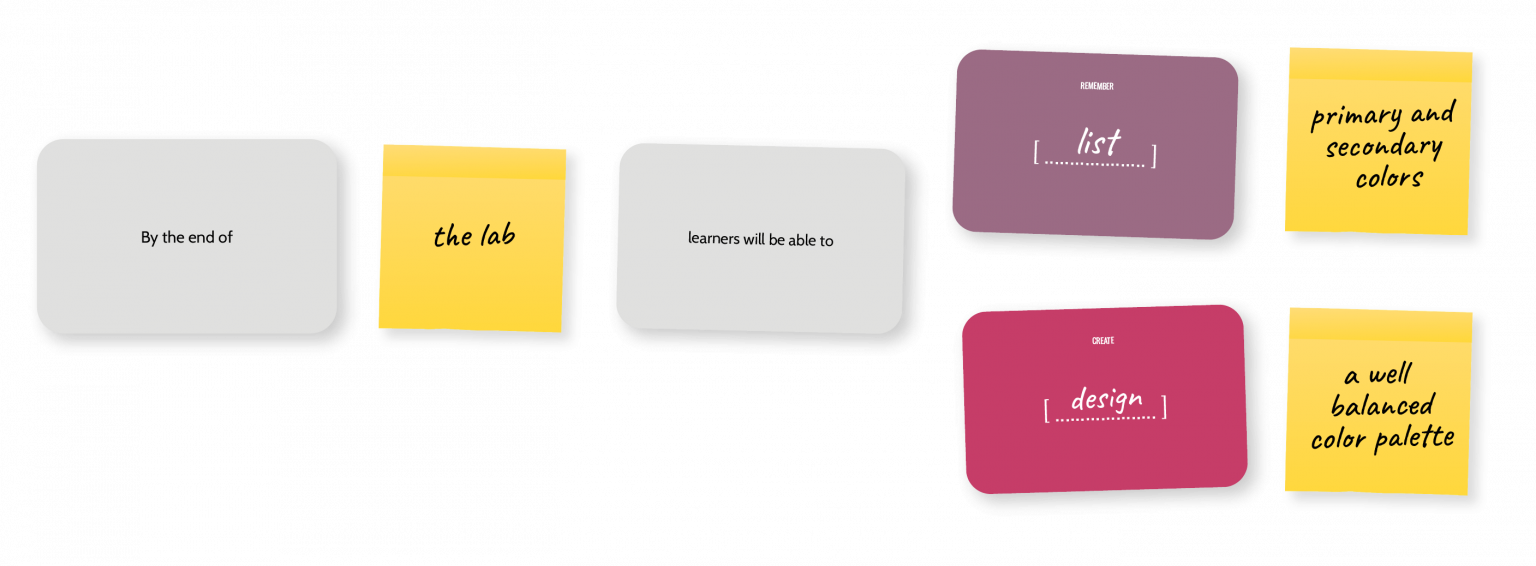

Assessment Strategy Composition
The additional set of assessment cards allows to define appropriate assessment strategies for the created learning objectives. Certain assessment techniques and strategies are more suitable than others for specific learning objectives according to the cognitive level of the taxonomy.
The assessment cards are divided into 3 levels, each one corresponding to 2 levels of Bloom’s Taxonomy. The first group can be used with the Remember & Understand dimensions, the second with the Apply & Analyze dimensions, and the third with the Evaluate & Create dimensions to ensure constructive alignment of the assessment mechanism to the cognitive dimension in the taxonomy.
The assessment cards are also divided into 3 types of assessment: Test, Performance and Project. Each type refers to a specific assessment strategy with different levels of complexity. Test refers to written and oral examination, performance refers to practice that can be directly observed and project refers to complex artefacts that can serve to demonstrate competencies and skills indirectly.
Through an extension of the learning objective statement, the assessment cards are used to select from a wide range of constructively aligned assessment mechanisms that match the addressed cognitive dimensions of the learning objective. As a result, both the learning objective and the assessment strategy are constructively aligned and conceptually consistent.
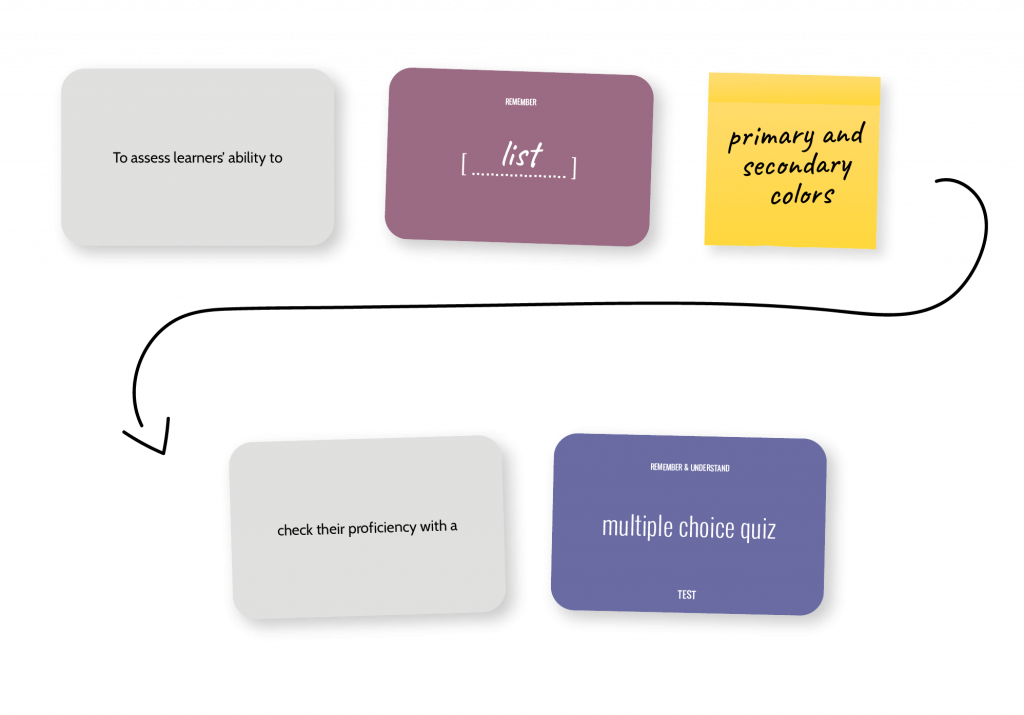
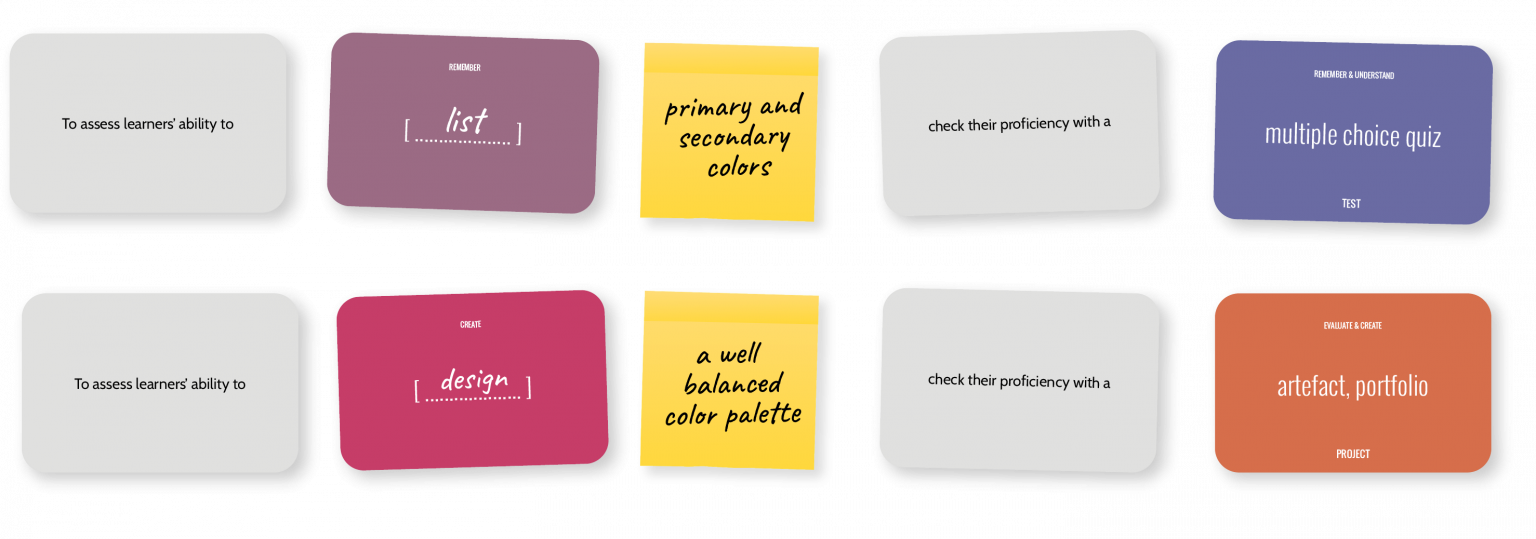

Constructive Alignment
If the focus of the design process is specifically aimed at the constructive alignment between outcomes and assessment strategies, the cards can be used to compose unique sentences which addresses both the learning objectives and the assessment mechanisms.
This process can also be utilized on a set of existing learning objectives to extend them towards appropriate and constructively aligned assessment mechanisms.
This compositional approach emphasises constructive alignment between outcomes and assessment as advocated by scholars in the field. The method nudges educators to take into account both aspects at the same time, thinking of learning objectives and assessment as part of a unified and coherent design process.
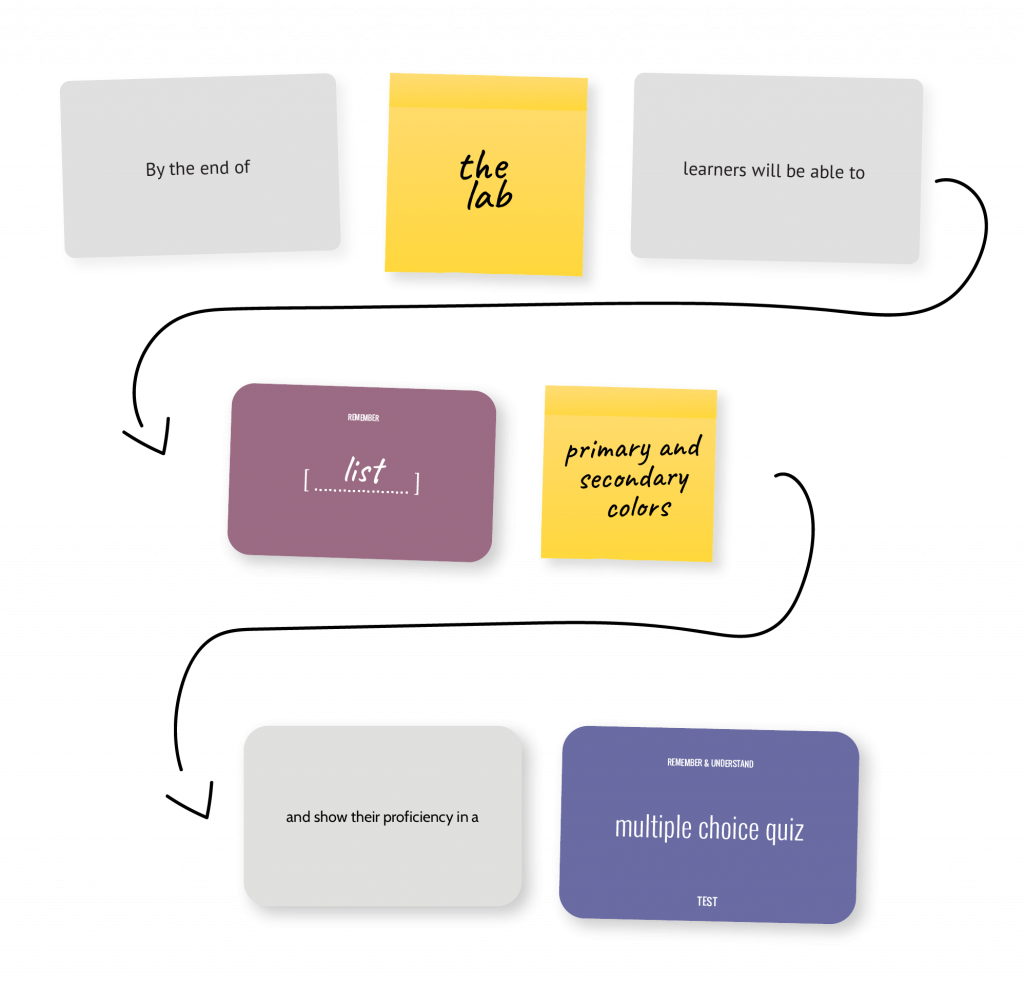


Learn how to create effective learning outcomes in a collaborative workshop with your team or faculty.
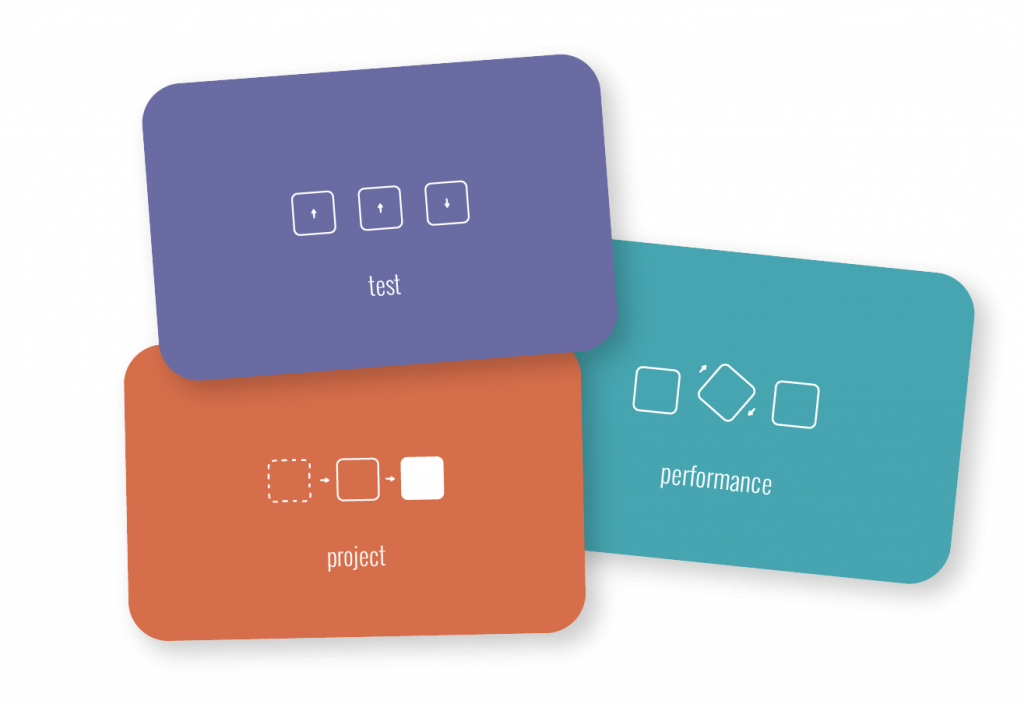
Learning Assessment Design Deck
Choose between a free downloadable version of the card deck that you can print and cut to get started or a real card deck that will last. Pick what works for you.

Learning Assessment Design Deck by Imaginary Institute is licensed under CC BY 4.0
Credits
Revised Bloom’s Taxonomy by: Anderson et al. (2001). A taxonomy for learning, teaching, and assessing: A revision of Bloom’sTaxonomy of Educational Objectives. New York: Longman.
The Three Classifications – simplified by: Guilbert, J.J. (1998). Educational Handbook for Health Personnel. Geneva, Switzerland: World Health Organization.
Simple Competence Model by: Miller, G.E. (1990). The assessment of clinical skills/competence/performace. Academic Medicine, 65(9), pp. 63-67.
Constructive Alignment by: Biggs, J. (1996). Enhancing teaching through constructive alignment. Higher education, 32(3), 347-364.
Icons by: network – By Juan Pablo Bravo, CL ; dots – By Muneer A.Safiah, PS ; cube – By Ates Evren Aydinel, TR ; cube – By Gregor Cresnar ; dots – By emilegraphics, NL ; dots – By Alexander Skowalsky, HU ; Network – By Alexander Skowalsky, HU ; Sphere – By Alexander Skowalsky, HU ; cube – By Creative Stall, PK ; cube – By Three Six Five ; cubes – By CAMB, DE ; cubes – By Vertigophase, GB ; cube – By nauraicon
All icons are licensed under a CC Attribution 3.0 Unported License
Also consider our other Learning Design Card Decks:
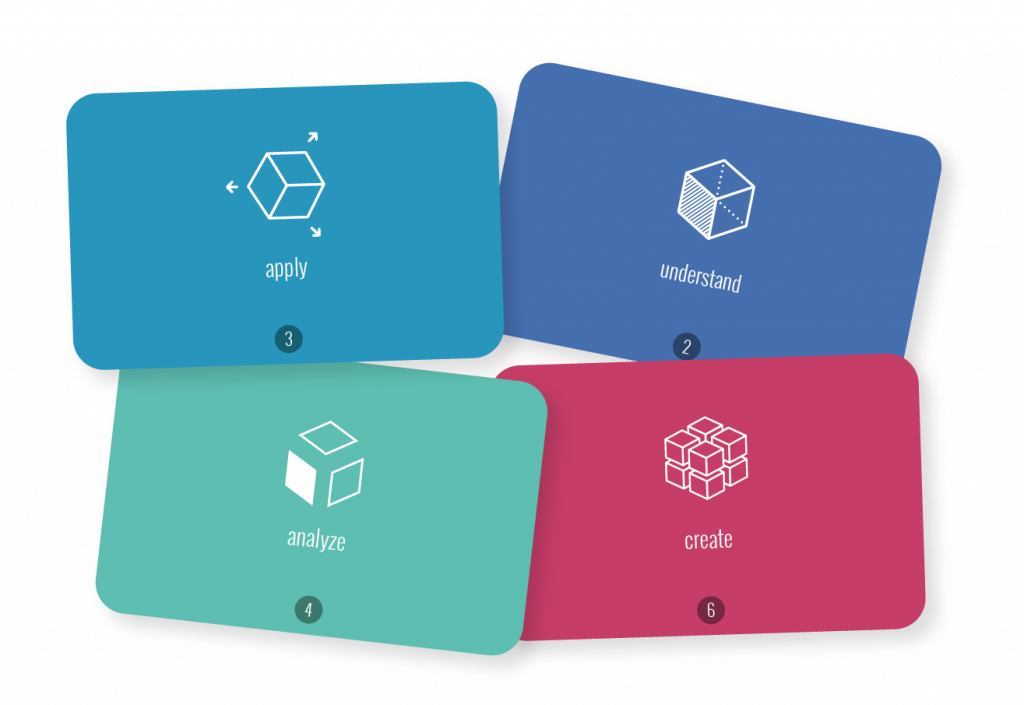
Learning Objective Design Deck
Choose between a free downloadable version of the card deck that you can print and cut to get started or a real card deck that will last. Pick what works for you.

Learning Objective Design Deck by Imaginary Institute is licensed under CC BY 4.0
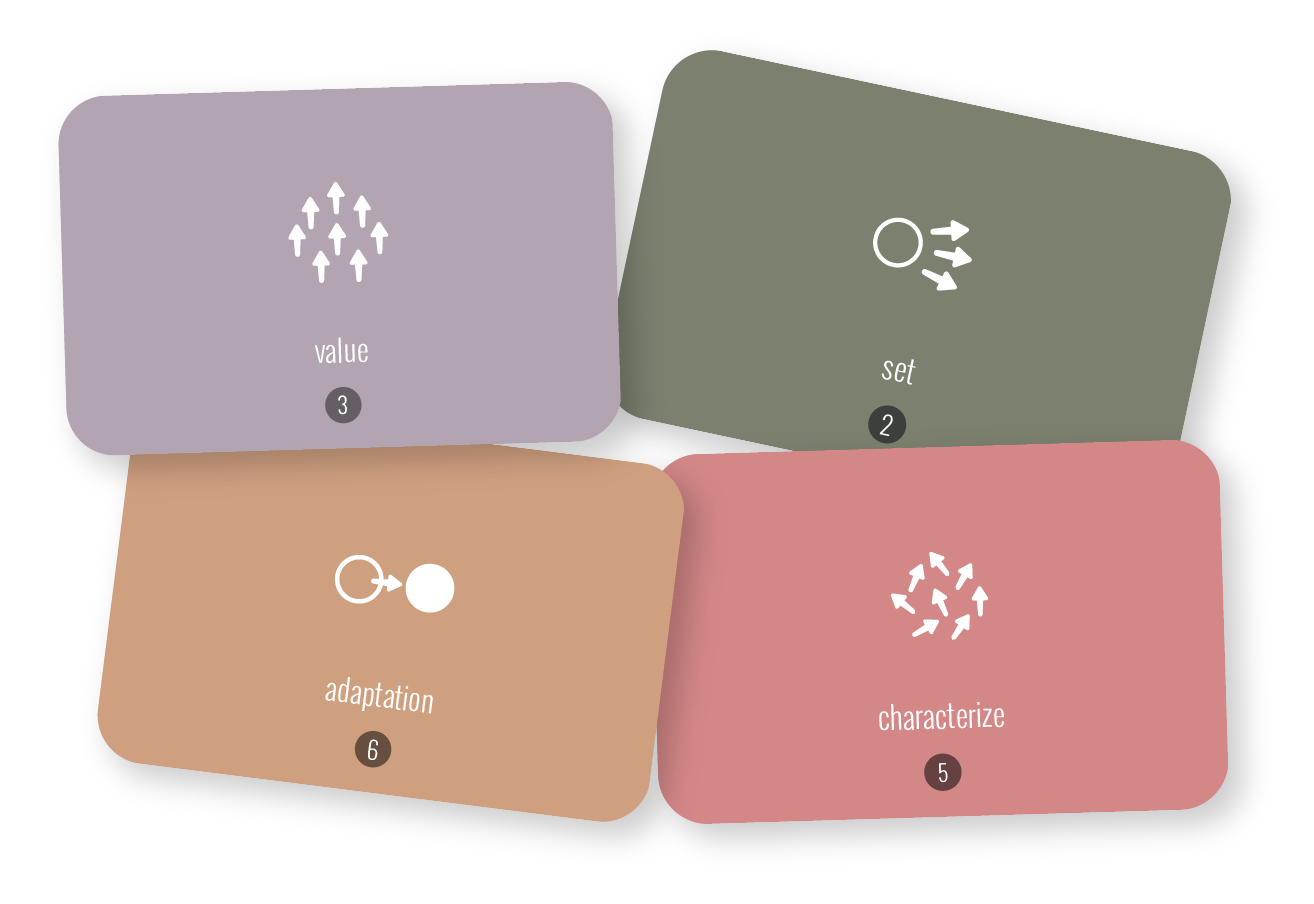
Learning Objective Design DeckExpansion Pack
Choose between a free downloadable version of the card deck that you can print and cut to get started or a real card deck that will last. Pick what works for you.

Learning Objective Design Deck Expansion Pack by Imaginary Institute is licensed under CC BY 4.0
